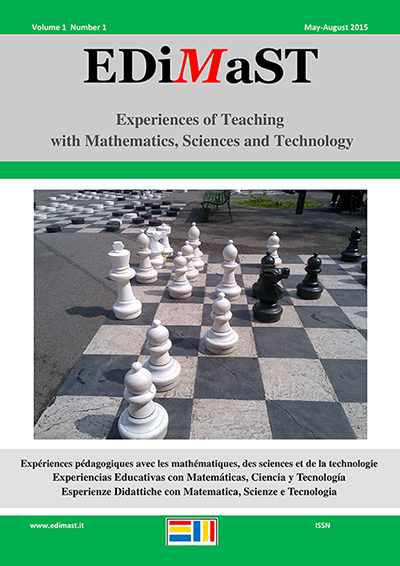Self-Regulation and Flipped Classroom to learn Mathematics
Keywords:
Flipped Classroom, Self Regulated Learning, ICT, Mathematics education, Teaching and Learning, Blended Learning, Inverted Classroom,Abstract
This article describes an experience that aims to explain how new teaching strategies like the Flipped Classroom Technique (FC), the Self Regulated Learning (SRL) and the use of ICTs, combined together, can provide a new and more effective way of teaching mathematics in secondary and high school without adding extra-curricular hours. It has paid particular attention to the self-regulated competences that the teacher acquires and the effectiveness of the techniques in term of autonomy, method and knowledge developed by the students.
Key
References
Anichini G., Arzarello F., Ciarrapico L., Robutti O., (2004). New mathematical standards for the school from 5 through 18 years, UMI-CIIM MIUR.
Azevedo R., Moos D.C., Johnson A.M., Chauncey A.D., (2010). La misurazione dei processi di regolazione cognitiva e metacognitiva durante lo studio con gli ipermedia. TD Tecnologie Didattiche, (Vol. 49, pp. 4-12).
Barbier R., (2007). La ricerca–azione, Armando Editore, Roma.
Behisuizen J., (2008). Does a community of learners foster self-regulated learning?. Technology, Pedagogy and Education. 17(3), 183–193.
Bergmann J., Sams A., (2014). Flipped learning: Gateway to student engagement, ISTE, Eugene, Oregon, Washington DC.
Bonaiuti G., (2014). Le strategie didattiche, Carocci-Faber, Roma.
Calvani A., (2011). Principi dell’istruzione e strategie per insegnare, Carocci, Roma.
Calvani A., (2014). Come fare una lezione efficace, Carocci-Faber, Roma.
Clark R.C., Nguyen F., Sweller J., (2006). Efficiency in Learning. San Francisco, Pfeiffer.
Davidson C.N., Goldberg D., (2009). The Future of Thinking. Learning Institutions in a Digital Age, Boston, MA: The MIT Press. http://mitpress.mit.edu/sites/default/files/titles/free_download/9780262513593_Future_of_Learning.pdf , (verificato accesso 15/05/2015).
Fulton K., (2012). Upside down and inside out: Flip Your Classroom to Improve Student Learning, Learning & Leading with Technology, vol. 39, pp. 12-17.
Gage N., (1963). Handbook of research on teaching, Rand McNelly & C., Chicago.
Graham, Harris, Reid, (1992). Developing self-regulated learners, Focus on Exceptional Children, 24(6), 1-16.
Hakkarainen K., Lipponen L., Järvelä S., (2002). Epistemology of Inquiry and Computer-Supported Collaborative Learning. In T. Koschmann, R. Hall, N. Miyake (Eds), CSCL2: Carrying Forward the Conversation. Mahwah, NJ: Erlbaum Ass.,129-156.
Hattie J., (2012). Visible Learning for Teachers: Maximizing Impact on Learning, Routledge, London.
Herreid C.F., Schiller N.A., (2013). Case studies and the flipped classroom, Journal of College Science Teaching, vol. 42, pp. 62-66.
Khan Academy, https://it.khanacademy.org/ (verificato in data 15/05/2015).
Ligouras P., (2012). Tra Tradizione e Innovazione Affrontare le Prove Invalsi di Matematica, Atti del Convegno Didamatica 2012 – Informatica per la Didattica, Taranto, 14-16 Maggio 2012, a cura di: T. Roselli, A. Andronico, F. Berni, P. Di Bitonto, V. Rossano, 10 pagine, ISBN: 9788890540677.
Ligouras P., (2013). Tecnologie e Strategie per la Didattica della Matematica, AGA editrice.
Ligouras P., Impedovo M.A., (2014). Attività didattiche online: il punto di vista del netteacher di matematica, Atti del Convegno Didamatica 2014 – Informatica per la Didattica: Nuovi Processi e Paradigmi per la Didattica, Napoli, 8, 9, 10 maggio 2014 - a cura di: Antonino Mazzeo, ISBN 978-8898091317, pp. 490-499.
Ligouras P., Impedovo M.A., (2015). Flipped Classroom e Self-Regulation per insegnare la Matematica, Atti del Convegno Didamatica 2015 – Studio ergo Lavoro. Dalla società della conoscenza alla società delle competenze, Genova 15, 16 e 17 Aprile 2015 - a cura di: Giovanni Adorni, Mauro Coccoli, Frosina Koceva, ISBN 978-88-98091-38-6, pp. 186-193.
Millard E., (2012). 5 Reasons Flipped Classrooms Work, University Business, p.26-29.
Nielsen L., (2012). Five Reasons I’m Not Flipping Over The Flipped Classroom, Technology and Learning, Vol. 32, No.10, p. 10-46.
Paoletti G., (2009). Saper Studiare, Carocci, Roma.
Pavarani A., (2014). Flipped Classroom, Tesi di Laurea, Università di Bologna.
Pintrich P.R., (2000). The role of goal orientation in selfregulated learning. In Boekaerts M., Pintrich P.R., Zeinder M., eds., Handbook of self-regulation. San Diego, CA: Academic Press. 451–502.
Randi J., Corno L., (2000). Innovazioni insegnanti in self-regulated learning. In Boekaerts M., P.R.
Schmidt S.M.P., (2014). The Flipped Classroom: A Twist On Teaching, The Clute Institute International Academic Conference, San Antonio, Texas, 98-104.
Sfard A., (2009). Psicologia del pensiero matematico. Trento, Erickson.
Syam M.I., (2014). Possibility of applying flipping classroom method in mathematics classes in foundation program at Qatar university, Proceedings of SOCIOINT14- International Conference on Social Sciences and Humanities, Turkey, 180-187.
TED, http://www.ted.com/, (verificato in data 15/05/2015).
Triantafyllou E., Timcenko O., (2015). Introducing a flipped classroom for a statistics course: A case study, EAEEIE (EAEEIE), 2014 25th Annual Conference, 5-8.
Wenger E., (2006). Comunità di pratica, Raffaello Cortina Editore, Milano.
Winne P.H., Perry N.E., (2000). Misurazione autoregolato apprendimento. In Boekaerts M., P. R. Pintrich, & M. Zeidner, Manuale di auto-regolamentazione. Indicazioni e le sfide per la ricerca futura. Academic Press, San Diego.
Zanichelli Editore, https://www.youtube.com/user/zanichellieditore, (verificato in data 15/05/2015).
Zimmerman B.J., (1990). Theories of Self-Regulated Learning and Academic Achievement: An Overview. Educational Psychologist, 25(1), 3-17.
Zimmerman B.J., (1998). Developing self-fulfilling cycles of academic regulation: An analysis of exemplary instructional models. In D. Schunk e B.J. Zimmermann (Eds.), Self Regulated learning: From teaching to self reflective practice. New York, London: The Guilford Press, 1-199.





